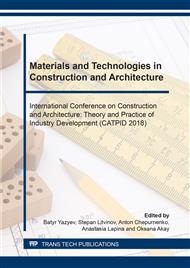[1]
G. A. Ptichnikova, A. V. Antyufeev, New morphotypes of architectural space of modern cities, Sociology of City. 2 (2014) 5-19. (in Russian).
Google Scholar
[2]
O. Opuchovicn, Ai. Kareiva, Historical hematite pigment: Synthesis by an aqueous sol–gel method, characterization and application for the colouration of ceramic glazes, Ceramics International. 41 (2015) 4504-4513.
DOI: 10.1016/j.ceramint.2014.11.145
Google Scholar
[3]
R.C. da Silva, S.A. Pianaro, S.M. Tebcherani, Preparation and characterization of glazes from combinations of different industrial wastes, Ceramics International. 38 (2012) 2725-2731.
DOI: 10.1016/j.ceramint.2011.11.041
Google Scholar
[4]
C. Rathossi, Y. Pontikes, Effect of firing temperature and atmosphere on ceramics made of NW Peloponnese clay sediments. Part I: Reaction paths, crystalline phases, microstructure and colour, Journal of the European Ceramic Society. 30 (2010).
DOI: 10.1016/j.jeurceramsoc.2010.02.002
Google Scholar
[5]
L. Maritan, L. Nodari, C. Mazzoli, A. Milano, U. Russo, Influence of firing conditions on ceramic products: Experimental study on clay rich in organic matter, Applied Clay Science. 31 (2006) 1-15.
DOI: 10.1016/j.clay.2005.08.007
Google Scholar
[6]
V.I. Reznik, Possibilities of production of facing and clinker brick of light colors on the basis of clays of PG Kislotoupor,, Building Materials. 4 (2011) 54-56. (in Russian).
Google Scholar
[7]
G.P. Vasyanov, B.F. Gorbachev, E.V. Krasnikova, R.K. Sadykov, R.R. Kabirov, Clay Fusible Ceramic Material of Tatarstan (Conditions of the Resource Base and Experience in Application of Light-Burning Multimineral Clays), Georesursy. 4(63) (2015).
DOI: 10.18599/grs.63.4.7
Google Scholar
[8]
Alberto De Bonis, Giuseppe Cultrone, Celestino Grifa, Alessio Langella, Antonio P. Leone, Mariano Mercurio, Vincenzo Morra, Different shades of red: The complexity of mineralogical and physicochemical factors influencing the colour of ceramics, Ceramics International. 43 (2017).
DOI: 10.1016/j.ceramint.2017.03.127
Google Scholar
[9]
S.R. Prim, M.V. Folgueras, M.A. de Lima, D. Hotza, Synthesis and characterization of hematite pigment obtained from a steel waste industry, Journal of Hazardous Materials. 192 (2011) 1307-1313.
DOI: 10.1016/j.jhazmat.2011.06.034
Google Scholar
[10]
V.F. Rasskazov, G.D. Ashmarin, A.N. Livada, Production of building materials using technogenic waste, Steklo I Keramika. 1 (2009) 5-9. (in Russian).
Google Scholar
[11]
L.P. Shchukina, E.V. Lyubova, I.V. Bilan, M.F. Kartavenko, The use of anthropogenic waste for production of facing ceramic brick, Building Materials. 8 (2010) 28-30. (in Russian).
Google Scholar
[12]
Emel Ozel, Gurkan Unluturk, Servet Turan, Production of brown pigments for porcelain insulator applications, Journal of the European Ceramic Society. 26 (2006) 735-740.
DOI: 10.1016/j.jeurceramsoc.2005.06.037
Google Scholar
[13]
C. Gargori, S. Cerro, R. Galindo, A. Garcı´a, M. Llusar, J. Badenes, G. Monro´s, New vanadium doped calcium titanate ceramic pigment, Ceramics International. 37 (2011) 3665-3670.
DOI: 10.1016/j.ceramint.2011.06.027
Google Scholar
[14]
Xiang Zhang, Guojun Man, Yibiao Jin, Puhong Cheng, Preparation of ceramic tiles with black pigments using stainless steel plant dust as a raw material, Ceramics International. 40 (2014) 9693-9700.
DOI: 10.1016/j.ceramint.2014.02.050
Google Scholar
[15]
A.Yu. Stolboushkin, Improving decorative properties of ceramic wall materials produced of technogenic and natural resources, Building Materials. 8 (2013) 24-32.
Google Scholar
[16]
A.Yu. Stolboushkin, S.G. Saybulatov, G.I. Storozhenko, Technological evaluation of the slagy part of the AEAF iron ore beneficiation wastes as a raw material for the ceramic building materials industry, Complex Use of Mineral Resources. 10 (1992).
Google Scholar
[17]
A.Yu. Stolboushkin, D.V. Akst, A.I. Ivanov, O.A. Fomina and V.A. Syromyasov, Russian Federation Patent 2,641,533. (2018).
Google Scholar
[18]
A.Yu. Stolboushkin, A.S. Fomin, O.A. Stolboushkina, Technogenic raw materials with vanadium component, Applied Mechanics and Materials. 756 (2015) 250-256.
DOI: 10.4028/www.scientific.net/amm.756.250
Google Scholar


